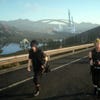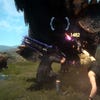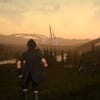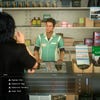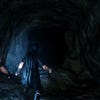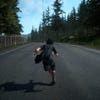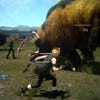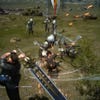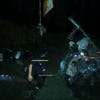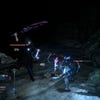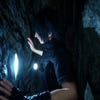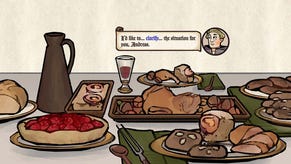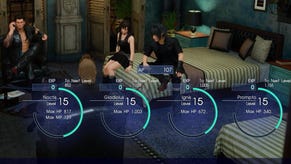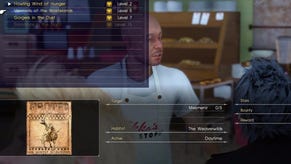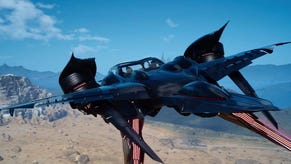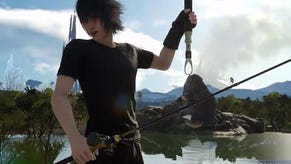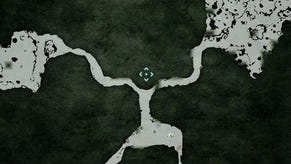Final Fantasy 15's demo gives us new hope for the series
Hitting the ol' Duscae trail.
I've spent hundreds of hours exploring the worlds of Final Fantasy. Between battling Ultimate Weapons, collecting Celestial weapons, playing cards, playing ball and hunting down secret summons and characters, I've lost days, possibly even entire weeks, to past series entries, all told. So, when I'm given just a single hour to explore a vast expanse of land in the Final Fantasy 15 demo, Episode Duscae, I panic.
Episode Duscae begins with protagonist Noctis, or Noct, waking up in a tent with his three travelling companions, each bestowed a name that just rolls off the tongue - Prompto, Ignis and Gladiolus. Much has been made of the fact that the party members revealed thus far (aside from being universally male) all appear as though their outfits were chosen and colour-co-ordinated by Simon Cowell, and going by what little I'd seen of them in previous trailers, I was expecting to dislike them immediately. As the introductory cut-scene plays, Noctis' alarm rings and one by one the characters stir and spout some arbitrary dialogue, and I feel certain I'm not going to enjoy this. But then the party steps outside their tent, blinking in the morning sun, and I stand for a good few minutes just swishing the camera around, panning in different directions and drinking in the view. The first five minutes of the 60-minute demo were spent just standing still and looking.
Noctis, revealed as a prince in previous trailers, is apparently slumming it on the side of a road with his pals as the car they had been travelling in has broken down, so the party must raise funds in order for it to be repaired so they can continue on their journey. There's a bounty being offered on a particularly nasty behemoth - affectionately nicknamed Dead Eye - which I'm encouraged to hunt down for a big cash boost, but for now I'm free to go in any direction I like.
The wide-open area in which the demo takes place, named Duscae, is vast and sweeping, with rolling hills giving way to forests and a lake surrounded by quiet meadows and long grass. In the lake, gigantic Diplodocus-like creatures amble and spray water. Herds of animals gather and scatter in waves, and birds soar overhead. On the horizon, a gleaming crystal shard stretches to the heavens. It's all very beautiful, but beauty has never been a problem for the Final Fantasy series.
What has been an issue in later entries to the series, for many fans, is marrying that beauty to a meaningful, relatable story and satisfying combat mechanics updated for a modern age. My problem with the Fabula Nova Crystallis mythos of the Final Fantasy 13 games was that there was never a moment where its world came to life for me, where it ever felt like it existed beyond the confines of the area I found myself in. Midgar, Besaid, Balamb, Narshe - these earlier locales all felt like places where people lived and things happened. Duscae feels like that too.
As I set out to explore and make the most of the little time I have, the first creatures I meet are two snuffling, buffalo-like grazers called Garula (which made their series debut in Final Fantasy 5). Wanting to test out combat, I run towards the closest one, until I realise it's a mother with her baby and feel disproportionately guilty about almost upsetting Duscae's ecosystem. I skulk off in search of more deserving targets, and soon quite literally stumble over a pack of Sabretusks, wolf-like animals I'm immediately vindicated in attacking thanks to their aggression and overall spiky appearance. You can avoid most encounters on the world map if you like - once an aggressive party senses your presence a red bar will appear across the top of the screen, but it's only when that bar fills the screen that combat will commence, otherwise you can simply run away from whatever is looking for you.
Combat, once initiated, occurs in real-time, with you controlling Noct and the rest of the party taking care of themselves. On PS4, the square button performs physical attacks whilst triangle triggers whichever special attack Noct currently has equipped. Special attacks are mapped to the arsenal of weapons he carries; his Blood Sword enables a Drain Blade technique, for example, which converts damage dealt to HP, and a Wyvern Lance allows for Dragoon Jump, an ability that sees Noct jump off screen and come smashing down on the heads of his enemy, recovering a small amount of MP in the process.
Holding L1 puts Noct in a defensive state where he will dodge enemies that lunge for him, but this drains MP. Whilst in a defensive state you'll sometimes be given the fleeting opportunity to parry or team up with another party member to counterattack an enemy, which looks pretty flashy when successfully timed. Needless to say, this approach to combat is a far cry from early Final Fantasies, being more akin to the systems found in 12 and 13. It more closely resembles a modern hack-and-slash than an old-school turn-based Final Fantasy, and it can be difficult to settle into its flow at first - but after a few battles it begins to feel natural, and the counterattacks, which vary depending on the enemy, are supremely satisfying to pull off.
After wandering around and exploring for a time, it starts to get dark. Once night falls, the area becomes more dangerous; different enemies may appear and attack the party. You can continue to explore and take your chances with whatever's out there, or you can set up camp, rest, and cook food. As always with Final Fantasy, resting will replenish your HP and MP, but by cooking you can earn additional perks that will gradually wear off over the course of the following day. Gathering or purchasing ingredients can open up additional recipes that confer other buffs and bonuses. A stew, for example, might make your party immune to poison, but frying up a hearty meal of ham and eggs will have a different outcome. It's an interesting new feature that reminds me a little of meditation in The Witcher 2, in that you can use it to prepare for upcoming battles and boost your chances of success with appropriate status effects. Cooking and then resting will move the day/night cycle along and fast-forward to the next morning.
It wasn't the combat or the cooking that caused me to walk away from Episode Duscae with invigorated hope for Final Fantasy 15, however. It wasn't even when I encountered a wild Chocobo and gleefully chased it around the map for five minutes, or when I spotted a pick-up truck parked behind a Chocobo Ranch that looked suspiciously like a homage to the one used by Zack and Cloud in Final Fantasy 7. I had initially panicked that I wasn't going to experience enough of the side quests or secrets or systems in the demo in the short time that I had been allotted, but that fear melted away when I realised that I was having fun not doing very much at all; just looking, fighting, jumping (there's a dedicated jump button now), simply existing in the world.
It feels like a very long while since a Final Fantasy universe has felt like one I'd want to spend time in. I'm still not entirely convinced by the characters or that their chatter won't begin to grate after a few hours, but the juxtaposition of traditional Final Fantasy tropes and aesthetics with more modernised, realistic elements like the party's car and costumes didn't trouble me nearly as much as I thought it would. Where a few of the past series entries felt like you were being harried down a long corridor, funnelled from one fight to another, Final Fantasy 15 seems to appreciate the quieter moments as much as the whirl of battle or the excitement of exploring: cooking, wandering, telling stories, standing still and looking.
Originally published on 7th March 2015.


